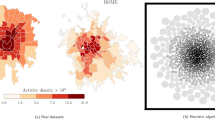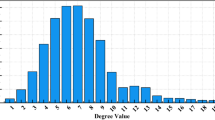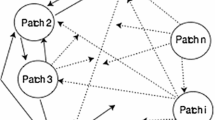Abstract
Multi-patch and multi-city models have been proposed to investigate the dynamics of disease propagation in discrete regions characterized by varying connectivity and movement rates. This paper aims to comprehensively explore the impact of network topology and travel rates on disease spread within a population represented by random networks of interconnected cities. This approach enables a more comprehensive analysis of disease outbreaks across spatial domains compared to conventional multi-patch models, which typically consider a limited number of homogeneous links among subpopulations within distinct spatial units (i.e., patches). In this study, cities are represented using a probabilistic cellular automaton model that incorporates local interactions among individuals, while the network’s edges represent the travel rates between pairs of cities (i.e., nodes). Two types of complex networks are considered, namely small-world and Barabási–Albert networks. By employing a flexible numerical model, this study surpasses previous models in its capacity to accommodate a larger number of patches or cities. The primary findings of this research reveal that reducing the travel rates within the network can potentially “flatten the curve” of infected cases; however, it does not impact the population’s basic reproduction number. To effectively reduce the reproduction number, localized interventions targeting disease transmissibility are required. Additionally, concentrating control efforts on “central” cities within the network may prove crucial in impeding the rapid propagation of the disease. In summary, this study employs a rigorous framework to investigate the influence of network topology and travel rates on disease spreading within a population represented by random networks of interconnected cities. The findings contribute to a comprehensive understanding of disease dynamics in complex spatial settings and inform targeted intervention strategies for controlling and mitigating infectious disease outbreaks.









Similar content being viewed by others
Data Availability
The datasets generated during and/or analyzed during the current study are available in the link https://bit.ly/3MloXCc. It is not in a repository due to the large size of the files.
References
Ahmed E, Agiza H, Hassan S (1998) On modeling hepatitis b transmission using cellular automata. J Stat Phys 92:707–712
Allen LJ, Bolker BM, Lous Y, Nevai AL (2007) Asymptotic profiles of the steady states for an SIS epidemic patch model. SIAM J Appl Math 67(5):1283–1309
Anderson RM, May RM (1991) Infectious diseases of humans: dynamics and control. Oxford University Press, Oxford Science Publications, Oxford
Aranha V (2005) Mobilidade pendular na metrópole paulistana. São Paulo Perspect 19:96–109
Arino J, Van Den Driessche P (2003) A multi-city epidemic model. Math Popul Stud 10(3):175–193. https://doi.org/10.1080/08898480306720
Arino J, Jordan R, van den Driessche P (2007) Quarantine in a multi-species epidemic model with spatial dynamics. Math Biosci 206(1):46–60
Balcan D, Gonçalves B, Hu H, Ramasco JJ, Colizza V, Vespignani A (2010) Modeling the spatial spread of infectious diseases: the global epidemic and mobility computational model. J Comput Sci 1(3):132–145
Barabási A-L, Albert R (1999) Emergence of scaling in random networks. Science 286(5439):509–512
Boccaletti S, Latora V, Moreno Y, Chavez M, Hwang DU (2006) Complex networks: structure and dynamics. Phys Rep 424(4–5):175–308
Castellazzo A, Mauro A, Volpe C, Venturino E (2012) Do demographic and disease structures affect the recurrence of epidemics? Math Model Nat Phenom 7(3):28–39
Chandrasekaran B, Fernandes S (2020) Since January 2020 Elsevier has created a COVID-19 resource centre with free information in English and Mandarin on the novel coronavirus. The COVID-19 resource centre is hosted on Elsevier Connect, the company ’ s public news and information website. Diabetes Metab Syndr 14(4):337–339
Chen S, Owolabi Y, Li A, Lo E, Robinson P, Janies D, Lee C, Dulin M (2020) Patch dynamics modeling framework from pathogens’ perspective: unified and standardized approach for complicated epidemic systems. PLoS One 15(10):1–18
Chinazzi M, Davis JT, Ajelli M, Gioannini C, Litvinova M, Merler S, Pastore y Piontti A, Mu K, Rossi L, Sun K, Viboud C, Xiong X, Yu H, Elizabeth Halloran M, Longini IM, Vespignani A (2020) The effect of travel restrictions on the spread of the 2019 novel coronavirus (COVID-19) outbreak. Science 368(6489):395–400
Cissé B, El Yacoubi S, Gourbière S (2016) A cellular automaton model for the transmission of Chagas disease in heterogeneous landscape and host community. Appl Math Model 40(2):782–794
Colizza V, Barthélemy M, Barrat A, Vespignani A (2007) Epidemic modeling in complex realities. C R Biol 330(4):364–374
Csardi G, Nepusz T (2006) The igraph software package for complex network research. Int J Complex Syst 1695:1–9
Cui Q, Qiu Z, Ding L (2017) An sir epidemic model with vaccination in a patchy environment. Math Biosci Eng 14(5–6):1141–1157
Diekmann O, Heesterbeek J, Roberts MG (2010) The construction of next-generation matrices for compartmental epidemic models. J R Soc Interface 7:873–885
Dorjee S, Revie CW, Poljak Z, McNab WB, Sanchez J (2013) Network analysis of swine shipments in Ontario, Canada, to support disease spread modelling and risk-based disease management. Prev Vet Med 112(1–2):118–27
Ferguson NM, Laydon D, Nedjati-Gilani G, Imai N, Ainslie K, Baguelin M, Bhatia S, Boonyasiri A, Cucunubá Z, Cuomo-Dannenburg G, Dighe A, Dorigatti I, Fu H, Gaythorpe K, Green W, Hamlet A, Hinsley W, Okell LC, Van Elsland S, Thompson H, Verity R, Volz E, Wang H, Wang Y, Gt Walker P, Walters C, Winskill P, Whittaker C, Donnelly CA, Riley S, Ghani AC (2020) Impact of non-pharmaceutical interventions (NPIs) to reduce COVID-19 mortality and healthcare demand, Faculty of Medicine/School of Public Health/Imperial College London, no. March, pp 3–20 (2020)
Fiocruz (2020) Regiões e redes COVID-19: Acesso aos serviços de saúde e fluxo de deslocamento de pacientes em busca de internação
Franc A (2004) Metapopulation dynamics as a contact process on a graph. Ecol Complex 1(1):49–63
Gostic KM, Gomez AC, Mummah RO, Kucharski AJ, Lloyd-Smith JO (2020) Estimated effectiveness of symptom and risk screening to prevent the spread of COVID-19. eLife 9:2
Gwizdałła T (2020) Viral disease spreading in grouped population. Comput Methods Programs Biomed 197:105715
Hu Z, Song C, Xu C, Jin G, Chen Y, Xu X, Ma H, Chen W, Lin Y, Zheng Y, Wang J, Hu Z, Yi Y, Shen H (2020) Clinical characteristics of 24 asymptomatic infections with COVID-19 screened among close contacts in Nanjing, China. Sci China Life Sci 63:706–711
IBGE (2021) Tábuas completas de mortalidade, Instituto Brasileiro de Geografia e Estatística. Accessed 16 June 23
Johansen A (1996) A simple model of recurrent epidemics. J Theor Biol 178(1):45–51
Kermack WO, McKendrick AG (1927) A contribution to the mathematical theory of epidemics. R Soc Lond Proc Ser A 115:700–721
Kheiri H, Jafari M (2019) Stability analysis of a fractional order model for the HIV/AIDS epidemic in a patchy environment. J Comput Appl Math 346:323–339
Klepac P, Megiddo I, Grenfell BT, Laxminarayan R (2016) Self-enforcing regional vaccination agreements. J R Soc Interface 13:1
Kouokam E, Auger P, Hbid H, Tchuente M (2008) Effect of the number of patches in a multi-patch SIRS model with fast migration on the basic reproduction rate. Acta Biotheor 56(1–2):75–86
Leonenko V, Arzamastsev S, Bobashev G (2020) Contact patterns and influenza outbreaks in Russian cities: a proof-of-concept study via agent-based modeling. J Comput Sci 44:101156
Liu J, Bai Z, Zhang T (2018) A periodic two-patch SIS model with time delay and transport-related infection. J Theor Biol 437:36–44
Ma S, Zhang J, Zeng M, Yun Q, Guo W, Zheng Y, Zhao S, Wang MH, Yang Z (2020) Epidemiological parameters of COVID-19: case series study. J Med Internet Res 22:10
Medrek M, Pastuszak Z (2021) Numerical simulation of the novel coronavirus spreading. Expert Syst Appl 166:114109
Monteiro LHA (2020) An epidemiological model for SARS-CoV-2. Ecol Complex 43:100836
Monteiro LHA, Fanti V, Tessaro A (2020) On the spread of SARS-CoV-2 under quarantine: a study based on probabilistic cellular automaton. Ecol Complex 44:100879
Moore C, Newman MEJ (2000) Epidemics and percolation in small-world networks. Phys Rev E 61(5):5678–5682
Mpolya EA, Yashima K, Ohtsuki H, Sasaki A (2014) Epidemic dynamics of a vector-borne disease on a villages-and-city star network with commuters. J Theor Biol 343:120–126
Nipa KF, Allen LJ (2020) Disease emergence in multi-patch stochastic epidemic models with demographic and seasonal variability. Bull Math Biol 82(12):1–30
Notas técnicas da Fiocruz (2022) https://bigdata-covid19.icict.fiocruz.br/. Accessed 10 May 2
Ogren P, Martin CF (2000) Optimal vaccination strategies for the control of epidemics in highly mobile populations. In: Proceedings of the 39th IEEE conference on decision and control (Cat. No.00CH37187), vol 2. pp 1782–1787
Ogren P, Martin CF (2002) Vaccination strategies for epidemics in highly mobile populations. Appl Math Comput 127(2):261–276. https://doi.org/10.1016/S0096-3003(01)00004-2
Prosper O, Ruktanonchai N, Martcheva M (2012) Assessing the role of spatial heterogeneity and human movement in malaria dynamics and control. J Theor Biol 303:1–14
Ramos ABM, Schimit PHT (2019) Disease spreading on populations structured by groups. Appl Math Comput 353:265–273
Rautureau S, Dufour B, Durand B (2010) Vulnerability of animal trade networks to the spread of infectious diseases: a methodological approach applied to evaluation and emergency control strategies in Cattle, France, 2005. Transbound Emerg Dis 58:110–120
Rock K, Brand S, Moir J, Keeling MJ (2014) Dynamics of infectious diseases. Reports on progress in physics. Phys Soc (Great Britain) 77(2):026602
Salmani M, van den Driessche P (2006) A model for disease transmission in a patchy environment. Discrete Continuous Dyn Syst - B 6(1):185–202. https://doi.org/10.3934/dcdsb.2006.6.185
Sander LM, Warren CP, Sokolov I, Simon C, Koopman J (2002) Percolation on disordered networks as a model for epidemics. Math Biosci 180:293–305
Schimit PHT, Monteiro LHA (2009) On the basic reproduction number and the topological properties of the contact network: an epidemiological study in mainly locally connected cellular automata. Ecol Model 220(7):1034–1042
Schimit PHT, Pereira FH (2018) Disease spreading in complex networks: a numerical study with principal component analysis. Expert Syst Appl 97:41–50
Senapati A, Sardar T, Ganguly KS, Ganguly KS, Chattopadhyay AK, Chattopadhyay J (2019) Impact of adult mosquito control on dengue prevalence in a multi-patch setting: a case study in Kolkata (2014–2015). J Theor Biol 478:139–152
Singhal T (2020) A review of coronavirus disease-2019 (COVID-19). Indian J Pediatr 87(4):281–286. https://doi.org/10.1007/s12098-020-03263-6
Sirakoulis GC, Karafyllidis I, Thanailakis A (2000) A cellular automaton model for the effects of population movement and vaccination on epidemic propagation. Ecol Model 133(3):209–223
Tanne JH, Hayasaki E, Zastrow M, Pulla P, Smith P, Rada AG (2020) COVID-19: how doctors and healthcare systems are tackling coronavirus worldwide. BMJ 368(March):1–5
Van Den Driessche P, Watmough J (2002) Reproduction numbers and sub-threshold endemic equilibria for compartmental models of disease transmission. Math Biosci 180(1–2):29–48
van Ravensway J, Benbow ME, Tsonis AA, Pierce SJ, Campbell LP, Fyfe JAM, Hayman JA, Johnson PDR, Wallace JR, Qi J (2012) Climate and landscape factors associated with Buruli ulcer incidence in Victoria, Australia. PLoS One 7(12):e51074
Verelst F, Kuylen E, Beutels P (2020) Indications for healthcare surge capacity in European countries facing an exponential increase in coronavirus disease (COVID-19) cases, March 2020. Eurosurveillance 25(13):1–4
Wang W, Zhao XQ (2006) An epidemic model with population dispersal and infection period. SIAM J Appl Math 66(4):1454–1472
Wang W, Zhao XQ (2008) Threshold dynamics for compartmental epidemic models in periodic environments. J Dyn Differ Equ 20(3):699–717
Watts D, Strogatz S (1998) Collective dynamics of small-world networks. Nature 393:440–442
Westgarth C, Gaskell RM, Pinchbeck GL, Bradshaw JWS, Dawson S, Christley RM (2009) Walking the dog: exploration of the contact networks between dogs in a community. Epidemiol Infect 137(8):1169–1178
Wolfram S (1994) Cellular automata and complexity: collected papers. Westview Press, New York
Wu JT, Leung K, Bushman M, Kishore N, Niehus R, de Salazar PM, Cowling BJ, Lipsitch M, Leung GM (2020) Estimating clinical severity of COVID-19 from the transmission dynamics in Wuhan, China. Nat Med 26:506–510
Xi W, Pei T, Liu Q, Song C, Liu Y, Chen X, Ma J, Zhang Z (2020) Quantifying the time-lag effects of human mobility on the COVID-19 transmission: a multi-city study in china. IEEE Access 8:216752–216761
Yakowitz S, Gani J, Hayes R (1990) Cellular automaton modeling of epidemics. Appl Math Comput 40:41–54
Zakary O, Larrache A, Rachik M, Elmouki I (2016) Effect of awareness programs and travel-blocking operations in the control of HIV/AIDS outbreaks: a multi-domains SIR model. Adv Differ Equ 1:2016
Zakary O, Rachik M, Elmouki I, Lazaiz S (2017) A multi-regions discrete-time epidemic model with a travel-blocking vicinity optimal control approach on patches. Adv Differ Equ 1:2017
Zhao S, Bauch CT, He D (2018) Strategic decision making about travel during disease outbreaks: a game theoretical approach. J R Soc Interface 15:9
Zhou T, Liu Q, Yang Z, Liao J, Yang K, Bai W, Lu X, Zhang W (2020) Preliminary prediction of the basic reproduction number of the Wuhan novel coronavirus 2019-ncov. J Evid Based Med 13(1):3–7
Funding
PHTS is supported by grants #440025/2020-6, #307194/2019-1 and #402874/2016-1 of Conselho Nacional de Desenvolvimento Científico e Tecnológico (CNPq) and grant #2017/12671-8, São Paulo Research Foundation (FAPESP).
Author information
Authors and Affiliations
Corresponding author
Ethics declarations
Conflict of interest
The authors declare that there are no conflicts of interest regarding the publication of this paper.
Ethical approval
Ethics approval was not required for this study.
Additional information
Communicated by Rafael Villanueva.
Publisher's Note
Springer Nature remains neutral with regard to jurisdictional claims in published maps and institutional affiliations.
Rights and permissions
Springer Nature or its licensor (e.g. a society or other partner) holds exclusive rights to this article under a publishing agreement with the author(s) or other rightsholder(s); author self-archiving of the accepted manuscript version of this article is solely governed by the terms of such publishing agreement and applicable law.
About this article
Cite this article
Quiroga, C.d.L., Schimit, P.H.T. A multi-city epidemiological model based on cellular automata and complex networks for the COVID-19. Comp. Appl. Math. 42, 288 (2023). https://doi.org/10.1007/s40314-023-02401-y
Received:
Revised:
Accepted:
Published:
DOI: https://doi.org/10.1007/s40314-023-02401-y




